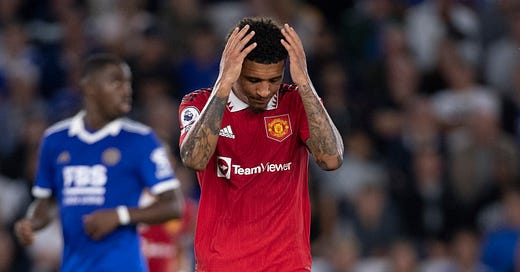The fall of Jadon Sancho
Jadon Sancho's challenging period at Manchester United appeared to conclude on Thursday as the club officially announced the 23-year-old's loan return to his former team, Borussia Dortmund.
Acquired in the summer of 2021 for €85 million, a transaction that stood as the club's third most costly transfer at the time, Sancho was anticipated to emerge as Manchester United's next prominent star. Unfortunately, after enduring two and a half challenging years that saw the winger contribute only 12 goals and six assists in 82 games, Sancho is now leaving Old Trafford as one of the club's most significant transfer disappointments. The question arises: What led to the downturn for the England international, and why did his Manchester United stint culminate in such a notable failure?
Failure in Scouting
Various factors contribute to a player's success or struggle at a particular club, and in Sancho's case at Manchester United, one significant challenge has been his inability to secure a consistent role in the first team. Whether under the management of Ole Gunnar Solskjaer, Michael Carrick, Ralf Rangnick, or Erik ten Hag, Sancho never had the opportunity to establish himself at the new club. In the last two and a half seasons at Old Trafford, the winger started more than five consecutive league matches only once. Much of this issue may stem from Manchester United's uncertainty about the type of player they had signed
In the span of his 82 appearances for Manchester United, Sancho featured as a left winger 55 times, on the right wing 19 times, as a central attacking midfielder three times, and occasionally even as a false No.9. This stands in stark contrast to his role at Dortmund, where he was consistently deployed as a wide player specializing in the inside forward position. As depicted in the graphic above, while Sancho proved versatile on either wing, his preference was evidently for the left side—a position highly sought after by several of his Manchester United teammates. This preference could be considered a key factor in Sancho's challenges and lack of success at Old Trafford.
Why Sancho didn't get game time at Old Trafford
Although Manchester United secured Sancho's signature in 2021, the club's pursuit of the Dortmund star commenced in early 2019. Toward the conclusion of the 2018/19 season, Manchester United had two standout forwards in Anthony Martial and Marcus Rashford, and there was a recognized need for genuine talent on the left wing to enhance the performances of inconsistent players like Daniel James and the aging Juan Mata. However, during the time that elapsed between Manchester United's initial interest in Sancho and the eventual signing of the winger, there was a noticeable tactical shift that essentially diminished the urgency and necessity of Sancho's arrival.
Following the arrival of Solskjaer as full-time manager, Rashford was shifted back to his preferred role on the left as his total game time on the left flank jumped from 23% to 82%. And as we can see in the graphic above, it worked wonders for the England international, as his goals and assists from that position skyrocketed from just four the previous season to an incredible 39. Man Utd’s favoured star finally looked like the player he had promised to be in the club’s youth academy, but unfortunately for Sancho he was doing so in the former Dortmund star’s preferred position.
Rashford wasn't the sole challenge for Sancho. Even if the new acquisition could secure the left-wing position over his compatriot, he faced competition from Paul Pogba, Anthony Elanga, Jesse Lingard, Edinson Cavani, Martial, Mata, and James, all either playing specifically in that position or in roles that involved drifting out wide. Additionally, the arrival of Cristiano Ronaldo in the same transfer window solidified him as the club's new No.9, requiring all other forwards to adjust around him. Consequently, in his inaugural season at the club, Sancho started only 16 times on the left wing, accumulating a total of 1,469 minutes of league football.
The introduction of new players and the subsequent disruption in tactics and formations played a role in Solskjaer's departure from the managerial position just four months after Sancho's arrival. Two interim head coaches preceded Ten Hag, who, in his first season at the club, made a significant transfer move by adding another wide player, Antony, to the already crowded array of attacking options. Despite outperforming the new Brazilian winger with more league goals and assists (nine), Sancho played 118 fewer minutes of football than Ten Hag's high-profile signing during that season.
Consequently, Sancho has largely functioned as a squad player during his tenure at Old Trafford, finding himself in a team that neither required his services nor displayed a significant inclination to displace established stars to assess his potential to replicate the form he exhibited at Dortmund. He emerged as a less-than-impressive talent, and it's possible that as a young player, he may not have been entirely prepared to take on a starring role for Manchester United in the Premier League. However, there's little doubt that Sancho became a significant victim of circumstances at Old Trafford and now seeks a new club in Germany where he can secure the crucial playing time he urgently needs.









Very insightful